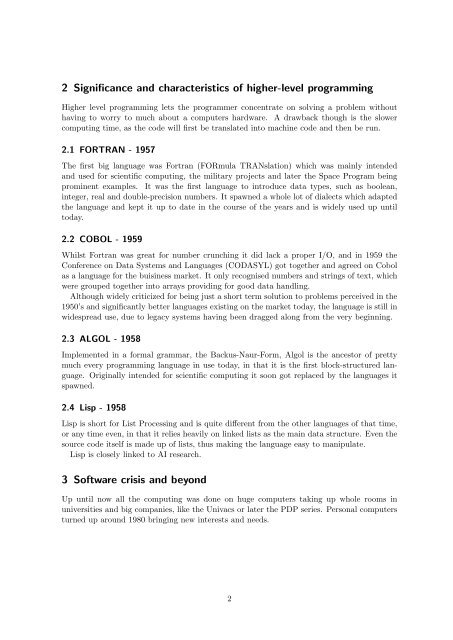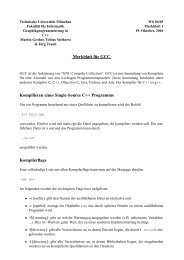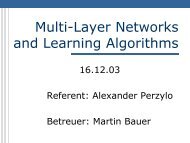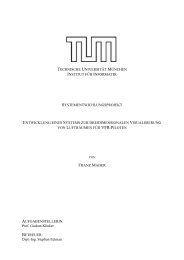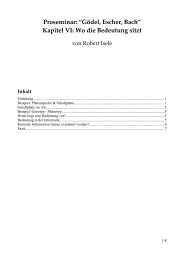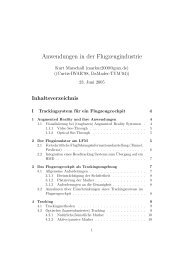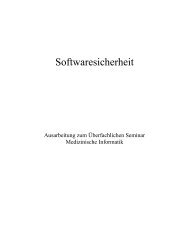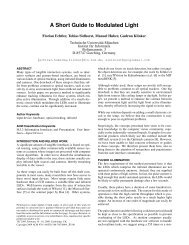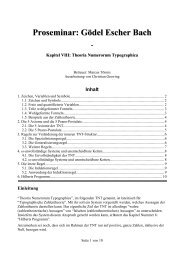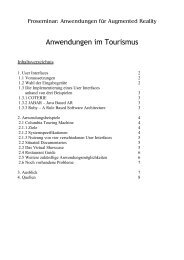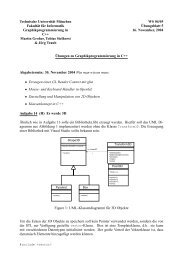A short history of programming languages 1 How computers and ...
A short history of programming languages 1 How computers and ...
A short history of programming languages 1 How computers and ...
You also want an ePaper? Increase the reach of your titles
YUMPU automatically turns print PDFs into web optimized ePapers that Google loves.
2 Significance <strong>and</strong> characteristics <strong>of</strong> higher-level <strong>programming</strong><br />
Higher level <strong>programming</strong> lets the programmer concentrate on solving a problem without<br />
having to worry to much about a <strong>computers</strong> hardware. A drawback though is the slower<br />
computing time, as the code will first be translated into machine code <strong>and</strong> then be run.<br />
2.1 FORTRAN - 1957<br />
The first big language was Fortran (FORmula TRANslation) which was mainly intended<br />
<strong>and</strong> used for scientific computing, the military projects <strong>and</strong> later the Space Program being<br />
prominent examples. It was the first language to introduce data types, such as boolean,<br />
integer, real <strong>and</strong> double-precision numbers. It spawned a whole lot <strong>of</strong> dialects which adapted<br />
the language <strong>and</strong> kept it up to date in the course <strong>of</strong> the years <strong>and</strong> is widely used up until<br />
today.<br />
2.2 COBOL - 1959<br />
Whilst Fortran was great for number crunching it did lack a proper I/O, <strong>and</strong> in 1959 the<br />
Conference on Data Systems <strong>and</strong> Languages (CODASYL) got together <strong>and</strong> agreed on Cobol<br />
as a language for the buisiness market. It only recognised numbers <strong>and</strong> strings <strong>of</strong> text, which<br />
were grouped together into arrays providing for good data h<strong>and</strong>ling.<br />
Although widely criticized for being just a <strong>short</strong> term solution to problems perceived in the<br />
1950’s <strong>and</strong> significantly better <strong>languages</strong> existing on the market today, the language is still in<br />
widespread use, due to legacy systems having been dragged along from the very beginning.<br />
2.3 ALGOL - 1958<br />
Implemented in a formal grammar, the Backus-Naur-Form, Algol is the ancestor <strong>of</strong> pretty<br />
much every <strong>programming</strong> language in use today, in that it is the first block-structured language.<br />
Originally intended for scientific computing it soon got replaced by the <strong>languages</strong> it<br />
spawned.<br />
2.4 Lisp - 1958<br />
Lisp is <strong>short</strong> for List Processing <strong>and</strong> is quite different from the other <strong>languages</strong> <strong>of</strong> that time,<br />
or any time even, in that it relies heavily on linked lists as the main data structure. Even the<br />
source code itself is made up <strong>of</strong> lists, thus making the language easy to manipulate.<br />
Lisp is closely linked to AI research.<br />
3 S<strong>of</strong>tware crisis <strong>and</strong> beyond<br />
Up until now all the computing was done on huge <strong>computers</strong> taking up whole rooms in<br />
universities <strong>and</strong> big companies, like the Univacs or later the PDP series. Personal <strong>computers</strong><br />
turned up around 1980 bringing new interests <strong>and</strong> needs.<br />
2


